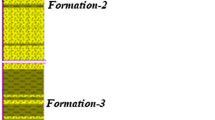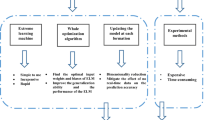Abstract
The rate of penetration (ROP) is one of the key factors that affect the drilling costs. Optimizing the ROP is a big challenge as it depends on many factors such as revolutions per minute (RPM), weight on bit (WOB), torque (T), horsepower (HP), and uniaxial compressive strength (UCS) of the drilled rocks. In addition, drilling fluid properties have a major effect on ROP. The main goal of this study is to develop a new ROP model using an artificial neural network (ANN) combined with the self-adaptive differential evaluation (SaDE) technique. The model was built using different drilling mechanical parameters and drilling fluid properties. A new ROP empirical correlation was developed by extracting the weights and biases of the optimized SaDE-ANN model. The optimized ANN architecture based on SaDE is 5-30-1, where five input parameters were used in the input layers to predict the ROP which are drilling fluid density to plastic viscosity ratio, RPM, WOB/D, T/UCS, and HP. The optimized number of neurons was 30 and the output layer consists of one output parameter which is ROP. The data was divided into 60% training and 40% testing. The developed ROP model based on SaDE-ANN showed high accuracy where the correlation coefficient (R) was 0.98 and the average absolute percentage error (AAPE) was 5%. The new ROP empirical correlation outperformed the previous ROP models.








Similar content being viewed by others
Abbreviations
- ROP:
-
rate of penetration, ft/h
- UCS:
-
uniaxial compressive strength, psi
- D :
-
mud density, pcf
- PV:
-
plastic viscosity, cP
- d :
-
bit diameter, in.
- WOB:
-
weight on bit, klbf
- T :
-
torque, klbf-ft
- P :
-
standpipe pressure, psi
- Q :
-
flow rate, gpm
- RPM:
-
revolutions per minute
- HP:
-
horsepower, HP
- R :
-
correlation coefficient
- R 2 :
-
coefficient of determination
- AAPE:
-
average absolute percentage error
- TVD:
-
true vertical depth, ft
- SaDE:
-
self-adaptive differential evolution
References
Aalst WMP, Rubin V, Verbeek HMW, Van Dongen BF, Kindler E, Günther CW (2010) Process mining: a two-step approach to balance between underfitting and overfitting. Softw Syst Model 9(1):87–111
Aguilar J, Prato F, Bravo C, Rivas F (2009) A multi-agent system for the management of abnormal situations in an artificially gas-lifted well. Appl Artif Intell 23(5):406–426. https://doi.org/10.1080/08839510902872256
Akcayol MA, Sagiroglu S (2007) Neuro-fuzzy controller implementation for an adaptive cathodic protection on Iraq-Turkey crude oil pipeline. Appl Artif Intell 21(3):241–256. https://doi.org/10.1080/08839510701196345
AlAjmi MD, Alarifi SA, Mahsoon AH (2015) Improving multiphase choke performance prediction and well production test validation using artificial intelligence: a new milestone. SPE-173394-MS, presented at the SPE Digital Energy Conference and Exhibition, held in The Woodlands, Texas, USA, 3-5 March
Alarifi SA, AlNuaim S, Abdulraheem A (2015) Productivity index prediction for oil horizontal wells using different artificial intelligence techniques. SPE-172729-MS, presented at the SPE Middle East Oil & Gas Show and Conference, held in Manama, Bahrain, 8-11 March
Ali JK (1994) Neural networks: a new tool for the petroleum industry. Paper SPE 27561presented in the European Petroleum Computer Conference, Aberdeen, U.K., 5-17 March
Arabjamaloei, Shadizadeh S (2011) Modeling and optimizing rate of penetration using intelligent systems in an Iranian southern oil field (Ahwaz oil field). Pet Sci Technol 29(16):1637–1648. https://doi.org/10.1080/10916460902882818
Armenta M (2008) Identifying inefficient drilling conditions using drilling specific energy. Paper SPE 116667 presented at the Annual Technical Conference and Exhibition held in Denver, Colorado, USA, 21–24 September
Bezminabadi S, Ramezanzadeh A, Esmaeil Jalali S, Tokhmenchi B, Roustaei A (2017) Effect of rock properties on ROP modeling using statistical and intelligent methods: a case study of an oil well in southwest of Iran. Arch Min Sci 62(1):131–144
Bilgesu HI, Tetrick LT, Altmis U, Mohaghegh S, Ameri S (1997) A new approach for the prediction of rate of penetration (ROP) values. Paper SPE-39231 presented at the SPE Eastern Regional Meetingber, Lexington, Kentucky, 22–24 October
Bingham MG (1965) A new approach to interpreting rock drillability. Petroleum Pub. Co.
Bourgoyne AT, Young FS (1974) A multiple regression approach to optimal drilling and abnormal pressure detection. J SPE 14(04):371–384
Chen F, Duan Y, Zhang J, Wang K, Wang W (2015) Application of neural network and fuzzy mathematic theory in evaluating the adaptability of inflow control device in horizontal well. J Pet Sci Eng 134(2015):131–142
Choubineh A, Helalizadeh A, Wood DA (2019) Estimation of minimum miscibility pressure of varied gas compositions and reservoir crude oil over a wide range of conditions using an artificial neural network model. Advances in Geo-Energy Research 3(1):52–66
Elkatatny SM (2017) New approach to optimize the rate of penetration using artificial neural network. Arab J Sci Eng 43:6297–6304. https://doi.org/10.1007/s13369-017-3022-0
Elkatatny S, Tariq Z, Mahmoud M (2016) Real time prediction of drilling fluid rheological properties using Artificial Neural Networks visible mathematical model (white box). J Pet Sci Eng 146:1202–1210
Elkatatny S, Mahmoud M, Tariq Z, Abdulraheem A (2017) New insights into the prediction of heterogeneous carbonate reservoir permeability from well logs using artificial intelligence network. Neural Comput & Applic 30:1–11. https://doi.org/10.1007/s00521-017-2850-x
Elkatatny SM, Zeeshan T, Mahmoud MA, Abdulraheem A, Mohamed I (2018a) An integrated approach for estimating static Young’s modulus using artificial intelligence tools. Neural Comput Applic
Elkatatny SM, Mahmoud MA, Moahmed I, Abdulraheem A (2018b) Development of a new correlation to determine the static Young’s Modulus. J Pet Explor Prod Technol 8(1):17–30
Fear MJ (1999) How to improve rate of penetration in field operations? SPE Drill Complet 14(01):1064–6671
Galle EM and Woods HB (1963) Best constant weight and rotary speed for rotary rock bits. Paper API-63-048 presented at the drilling and production practice, New York, 1 January
Hareland G, Wu A, Rashidi B and James JA (2010) A new drilling rate model for tricone bits and its application to predict rock compressive strength. Paper ARMA 10-206 presented at 44th U.S. Rock Mechanics Symposium and 5th U.S.-Canada Rock Mechanics Symposium, Salt Lake City, Utah, 27–30 June
Haykin (1998) Neural networks, a comprehensive foundation. Prentice Hall PTR, Upper Saddle River
He S (2009) Neural predictive force control for a hydraulic actuator: simulation and experiment. Appl Artif Intell 23(2):151–167. https://doi.org/10.1080/08839510802631752
Hossain ME, Al-Majed AA (2015) Fundamentals of sustainable drilling engineering. Scrivener Publishing LLC., 27 Feb
Isa D, Rajkumar R (2009) Pipeline defect prediction using support vector machines. Appl Artif Intell 23(8):758–771. https://doi.org/10.1080/08839510903210589
Jahanbakhshi R, Keshavarzi R and Jafarnezhad A (2012) Real-time prediction of rate of penetration during drilling operation in oil and gas wells. Paper ARMA-2012-244 presented at the 46th U.S. Rock Mechanics/Geomechanics Symposium, Chicago, Illinois, 24–27 June
Jain AK, Mao J, Mohiuddin KM (1996) Artificial neural networks: a tutorial. Computer 29(3):31–44
Karakul H (2018) Effects of drilling fluids on the strength properties of clay-bearing rocks. Arab J Geosci 11:450. https://doi.org/10.1007/s12517-018-3816-8
Khandelwal M, Singh TN (2011) Predicting elastic properties of schistose rocks from unconfined strength using intelligent approach. Arab J Geosci 4(3–4):435–442. https://doi.org/10.1007/s12517-009-0093-6
Kowakwi I, Chen H, Hareland G, Rashidi B (2012) The two-term rollercone rate of penetration (ROP) model with integrated hydraulics function. Paper ARMA-2012-246 presented at the 46th U.S. Rock Mechanics/Geomechanics Symposium, Chicago, Illinois, 24–27 June
Lippmann R (1987) An introduction to computing with neural nets. IEEE ASSP Mag 4(2):4–22
Maurer WC (1962) The “perfect-cleaning” theory of rotary drilling. J Pet Technol 14(11):1270–1274
Moussa TM, Awotunde AA (2018) Self-adaptive differential evolution with a novel adaptation technique and its application to optimize ES-SAGD recovery process. Comput Chem Eng 118:64–76. https://doi.org/10.1016/j.compchemeng.2018.07.018
Pessier RC and Fear MJ (1992) Quantifying common drilling problems with mechanical specific energy and a bit-specific coefficient of sliding friction, Paper SPE-24584 presented at the SPE Annual Technical Conference and Exhibition, Washington, D.C., USA, 4-7 October
Qin AK, Huang VL, Suganthan PN (2009) Differential evolution algorithm with strategy adaptation for global numerical optimization. IEEE Trans Evol Comput 13(2):398–417
Rumzan I and Schmitt DR (2001) The influence of well bore fluid pressure on drilling penetration rates and stress dependent strength. Paper ARMA-0100911 presented at 38th U.S. Rock Mechanics Symposium. Washington.
Schalkoff R (1997) Artificial neural networks. The University of Michigan: McGraw-Hill
Storn R, Price K (1997) Differential evolution – a simple and efficient heuristic for global optimization over continuous spaces. J Glob Optim 11(4):341–359
Su H, Ma H, Hu B, Qu C, Wang N (2018) An analysis of drilling fluid pumping pressure for the Maxi-HDD crossing project. Arab J Geosci 11:347. https://doi.org/10.1007/s12517-018-3708-y
Teale R (1965) The concept of specific energy in rock drilling. Int J Rock Mech Min Sci 2(1):57–73
Van SL, Chon BH (2017a) Effective prediction and management of a CO2 flooding process for enhancing oil recovery using artificial neural networks. ASME J Energy Resour Technol 140:032906. https://doi.org/10.1115/1.4038054
Van SL, Chon BH (2017b) Evaluating the critical performances of a CO2–enhanced oil recovery process using artificial neural network models. J Pet Sci Eng 157:207–222
Walker BH, Black AD, Klauber WP, et al (1986) Roller-bit penetration rate response as a function of rock properties and well depth. Paper SPE 15620 presented at the 61st Annual Technical Conference and Exhibition of the Society of Petroleum Engineers. New Orleans, LA October 5e8
Wang Q, Gao H, Jiang B, Yang J, LV Z (2018) Relationship model for the drilling parameters from a digital drilling rig versus the rock mechanical parameters and its application. Arab J Geosci 11:357. https://doi.org/10.1007/s12517-018-3715-z
Warren TM (1987) Penetration-rate performance of roller–cone bits. SPE Drill Eng 2(1):9–18
Winters WJ, Warren TM, Onyia EC, (1987) Roller bit model with rock ductility and cone offset. Paper SPE 16696 presented at the SPE Annual Technical Conference. Dallas, September 27–30
Wu A, Hareland G, Rashidi B (2010) The effect of different rock types and roller cone insert types and wear on ROP (rate of penetration). Paper ARMA-10-207 presented at the 44th U.S. Rock Mechanics Symposium and 5th U.S.-Canada Rock Mechanics Symposium, Salt Lake City, Utah, 27–30 June
Zhang Z, Yin J, Cheng Liu C (2018) A modular real-time tidal prediction model based on Grey-GMDH neural network. Appl Artif Intell 32(2):165–185. https://doi.org/10.1080/08839514.2018.1451220
Author information
Authors and Affiliations
Corresponding author
Ethics declarations
Conflict of interest
The author declares that there is no conflict of interest.
Rights and permissions
About this article
Cite this article
Elkatatny, S. Development of a new rate of penetration model using self-adaptive differential evolution-artificial neural network. Arab J Geosci 12, 19 (2019). https://doi.org/10.1007/s12517-018-4185-z
Received:
Accepted:
Published:
DOI: https://doi.org/10.1007/s12517-018-4185-z




